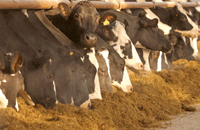Pushing up TMR can increase intakes

You can place a perfectly formulated, well-mixed TMR in front of a high yielding cow – but you can’t make her eat it. This is because smell, palatability, appetite, routine and group behaviour all play a part.
Just one cow moving up to eat can stimulate the others. So to keeping fresh palatable feed in front of cows is necessary. And in USA dairy herds, with ready access to affordable labour, fresh feed is routinely delivered four to six times a day. This is then pushed-up as many as six times a day.
Work by Trevor DeVries at the University of British Columbia has shown feeding times can increase by up to 82% in the first hour immediately following delivery of fresh feed. “Feeding twice a day increases total daily feeding time by 10 minutes, feeding four times increases feeding time by 14 minutes. There are no additional benefits more than four times,” he reports.
As cows eat, they sort food and push it away. This produces holes in the mix as they forage through it to reach the concentrates and pushing feed up puts it back in reach.
While frequent push-ups do not radically increase intakes or improve cow attendance at the trough, Dr DeVries confirms they stimulate cows to come up to eat. The result is more frequent, small meals throughout the day.
However, there are additional benefits. Subordinate cows have better access to feed as they are pushed away from the trough less often, and sorting behaviour is minimised.
Labour shortages
British herds struggling with labour shortages may find it impractical and expensive to adopt the American frequency of feeding. TMR has many virtues, but loading, mixing and feeding can be time consuming, admits independent nutritionist Rodney Allen.
He believes, working with key stimulation points which encourage cows to eat (particularly after milking and again after feed has been pushed up), can still achieve intakes with limited labour resources.
“Most of my clients – even 12,000kg herds – are feeding once a day due to sheer practicalities. The goal, however, is for five push-ups a day,” he says. “We need to employ every trick in the book to maintain dry matter intakes. Don’t forget every kg of dry matter is worth a couple of litres.”
Mr Allen stresses when dry matter intakes are less than optimum, cows will continue to produce litres by milking off their backs. Dips in energy balance then lead to fertility issues such as cystic ovaries, or cows not seen bulling.
Another problem he sees is cows developing calluses on the back of their necks as they try to reach food that’s out of reach.
“They rub their necks on the bottom rail trying to reach food. Herds therefore need to push-up food more often, raise the neck rail, or offset it more to increase the cow’s lunging area.”
As well as pushing feed back within reach, some clients have had a simple device made based on a wheel which both pushes and turns food over. “This presents fresh feed and stimulates cows to get up and is particularly useful during periods of heat stress when cows can be a bit lethargic.”
Case Study
John Torrance from Romford, Essex
Regularly pushing-up feed during the day is just basic attention to detail, according to John Torrance, Curtis Hill Holsteins, Romford, Essex. “Cows nose food away and we push it up regularly so they are not short. They all come up to eat when we feed out. We would probably see a drop in yield when they didn’t have feed in front of them all of the time,” he says.
The 300-cow herd, averaging 10,000kg, is fed once a day down central feed passages. “They work well. They are easily cleaned (so the job gets done) and grub doesn’t heat up. We have an attachment on the front of the loader which is easily picked up and dropped off. We push up before and after breakfast and lunch, again in the evening and last thing at night.”
